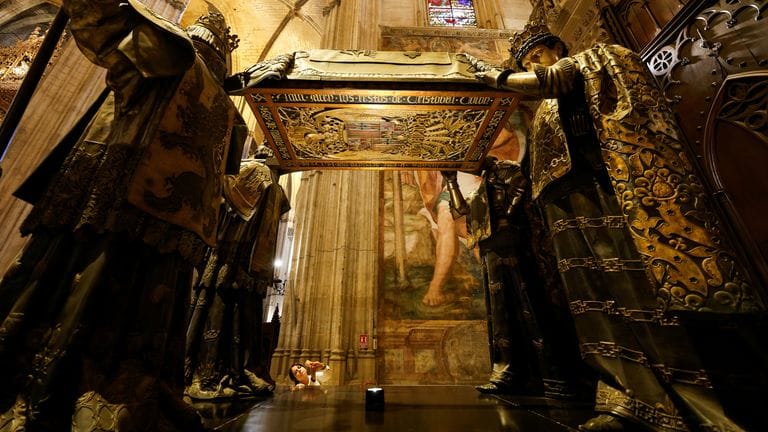An age-old mystery is about to be revealed – the origins of the explorer Christopher Columbus.
Spanish scientists have already used DNA analysis to confirm that his remains were buried in a tomb in Seville Cathedral in Spain.
Long cited by authorities as his final resting place, there have been competing claims – but now disputes over the 15th-century explorer’s nationality must also be put to rest.
A controversial figure, Columbus led Spanish-funded expeditions from 1490 onwards, paving the way for the European conquest of the Americas.
Many historians question the traditional theory that Columbus came from Genoa, Italy.
Other theories range from him being a Spanish Jew, Greek, Basque or Portuguese.
Researchers led by forensic expert Miguel Llorente tested small samples of remains buried in the cathedral, comparing them to those of his known relatives and descendants.
The findings are due to be announced in a documentary titled Columbus’s DNA: The True Origins on Spanish national television TVE on Saturday.
Findings are ‘almost absolutely reliable’
Briefing reporters on the study on Thursday, Llorente did not disclose the findings but said they confirmed previous theories that the remains in Seville belonged to Columbus.
“Today it was possible to verify this with new technologies, so the previous partial theory that the remains of Seville belonged to Christopher Columbus was finally confirmed,” he said.
He said the study of Columbus’ nationality was complicated by various factors, including the large amount of data, but said “the result is almost absolutely reliable.”
Read more from Sky News:
A former British athlete died at the age of 28
Ex-rock musician strangled girlfriend
Drugs found in a bag labeled “definitely not a bag full of drugs”
A traveler in life, Columbus was also a traveler in death. He died in Valladolid, Spain, in 1506, but wished to be buried on the island of Hispaniola, which today is shared by the Dominican Republic and Haiti.
His remains were transferred there in 1542, then moved to Cuba in 1795 and then – long thought to be in Spain – to Seville in 1898.
However, it is possible that some of Columbus’ remains still rest in the Caribbean.
In 1877, workers discovered a lead casket buried behind the altar in a cathedral in Santo Domingo, the capital of the Dominican Republic, containing a collection of bone fragments that the country believed belonged to Columbus.
Lorente said both claims may be true because both sets of bones are incomplete.
In recent years, there has been a push back against Columbus Day celebrations, which take place on October 12, marking his arrival in the Americas.
Nick Tilsen, president of the NDN Collective, an indigenous-led advocacy group, said the US should “celebrate that history is absolutely disrespectful.”
“Columbus was a lost explorer who came across this part of the world and brought famine, colonization, the death of millions of indigenous peoples,” he added.

